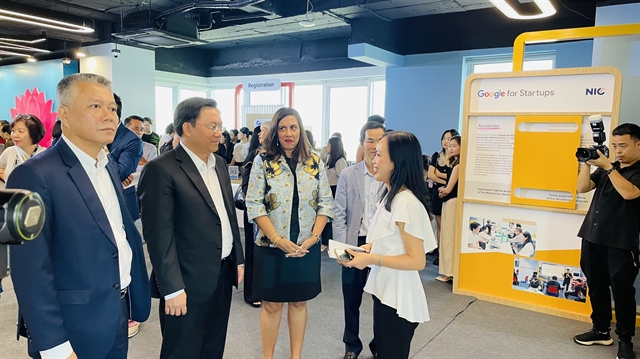 Economy
Economy

 |
| Deputy Minister of the Ministry of Planning and Investment Trần Duy Đông (centre) and guests, learn more about the programme. — VNS Photo Mai Hương |
HÀ NỘI — In a joint effort to propel Việt Nam's AI field forward, Google and the Việt Nam National Innovation Centre (NIC) on Thursday launched the 'Build for the AI Future' initiative.
This comprehensive programme aims to accelerate Việt Nam's progress in AI through two primary pillars, Build for Talent and Build for Start-ups. These are designed to empower Việt Nam’s workforce, nurture the start-up ecosystem and strengthen the foundations for widespread AI adoption.
Southeast Asia's digital economy has experienced rapid growth, expanding eightfold in eight years, to reach US$100 billion. The region's AI readiness, coupled with this digital transformation, positions Southeast Asia, including Việt Nam, to achieve up to $835 billion in economic benefits from AI by 2030.
Amid the AI technology boom, Việt Nam has made strong strides in research, application and work force skill development. In 2021, the Prime Minister issued the National Strategy on AI development until 2030. After three years, Việt Nam ranked 55th in AI readiness in 2022, up seven places from 2021, according to Oxford Insights.
“The ‘Build for the AI Future’ initiative, a collaboration between Google and NIC under the Ministry of Planning and Investment, demonstrates our unwavering commitment to fostering Việt Nam's AI ecosystem. This initiative equips the local workforce with essential skills for the AI era and supports the development of AI-driven innovations among Vietnamese start-ups,” said Deputy Minister of the Ministry of Planning and Investment Trần Duy Đông.
At the event, Marc Woo, Managing Director, Việt Nam, Google Asia Pacific, estimated that Việt Nam's digital economy will grow elevenfold by 2030, reaching $220 billion - almost half of the country's current GDP.
“AI is one of the key drivers to realising that forecast," said Mark Woo. "Together with NIC, we believe ‘Build for the AI Future’ will be a strong launchpad for Việt Nam’s local talents, start-ups and businesses that is well-leveraged on the best of Google AI's products and solutions.”
With a dynamic startup scene, a young, tech-savvy population (20 per cent of the total population) and supportive government policies, Việt Nam is well-poised to seize AI opportunities.
However, the nation faces a significant challenge - a shortage of AI specialists.
This scarcity, along with limited access to high-quality AI training programmes, creates a gap between market demand and available talent. Vietnamese AI start-ups also struggle with limited access to top AI experts and mentors, as well as a lack of infrastructure and tools needed for rapid AI product development, commercialisation and scaling up.
Regarding the programme, the Build for Talent offers 40,000 scholarships to the Google Career Certificates programme, including the newest AI Essentials course, targeting Vietnamese officials, lecturers, and students across 80 universities and colleges.
The Build for Start-ups focuses on empowering local green shoot businesses, recognising their critical role in innovation and solution development.
Đỗ Tiến Thịnh, Deputy Director of the NIC, said its collaboration with Google meant growth through support programmes and acceleration initiatives.
They have provided numerous scholarships for digital skills development, particularly in AI, aiming to enhance the start-up ecosystem, train IT professionals and advance AI applications in Việt Nam. He emphasised that beyond scholarships, Google's programmes promote a global standard of learning and offers flexibility, allowing participants to complete courses online in three to six months or at their own pace. — VNS